- remind me tomorrow
- remind me next week
- never remind me
The X Button
Other Subjects
by Todd Ciolek,

I've seen people criticize Metroid: Other M on several fronts: it uses awkward controls, it weakens Samus, it comes in one of those new DVD cases with the wheel-spoke holder that lets the disc get scratched easier, and so on. I'd like to complain about something else, though: the lack of aliens in recent Metroid games.
Sure, every Metroid has lots of alien lifeforms for Samus to destroy as she invades their natural environments. I'm not talking about those. I'm talking about the idea that peaceful, civilized aliens make up a good portion of Metroid's Galactic Federation. This is shown in various Metroid comics (more on those later) and a game ending or two. Hell, it was even part of the backstory in the original Metroid's manual, which depicts a roundtable of fretting alien dignitaries instead of some boring humans.
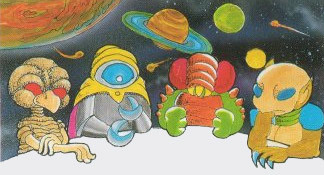
This is all swept aside in Other M, where nearly every Galactic Federation member, from the governing council to the soldiers that accompany Samus, is a human. Are species like the Chozo, the bird-people who made Samus' armor, extinct or really rare? Is the Federation driven by some pro-human bias? Whatever happened to aliens like that eyeless, buck-toothed thing up there? Not that more aliens would've made Other M better or worse, but I'd have one fewer thing to complain about.
NEWS
YUN AND YANG MAYBE SORTA JOIN SUPER STREET FIGHTER IV
Street Fighter producer Yoshinori Ono seems intent on not revealing any new characters before the Tokyo Game Show, but he's not above hinting very, very strongly about them. Blurry photos from his Twitter feed show what looks like Yun and Yang, two brothers from Hong Kong, in the arcade version of Super Street Fighter IV.
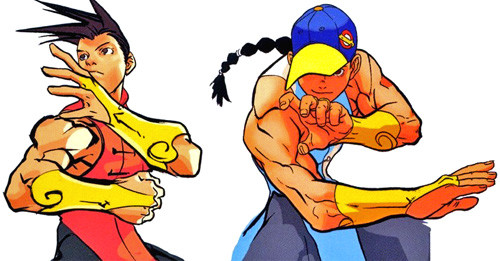
This is not yet official, of course, but Yun and Yang's skateboard and rollerblades appear in shadow in a recent Arcadia issue, and the brothers showed up in Chun-Li's story mode in Street Fighter IV. First introduced in Street Fighter III, Yun and Yang weren't brought up as often as some other fan-demanded additions for Street Fighter IV, but they're good choices. In fact, Yang was one of my favorite characters in Street Fighter III, so to all the people complaining that he's in SSFIV instead of, say, Rainbow Mika, I say neener neener neeeeenerrrr. Ahem. Well, anyway, we'll likely learn more about Yun, Yang, and any other new members of the Super Street Fighter IV roster at the Tokyo Game Show, kicking off September 16.
MEGA MAN UNIVERSE IS MEGA MAN 2
Mega Man creator Keiji Inafune spent the last month or so being vague about Mega Man Universe, but his plans for the game sounded ambitious indeed. Now there's a gameplay trailer showing off the initial results of those plans: the same Mega Man game we were playing back in 1989.
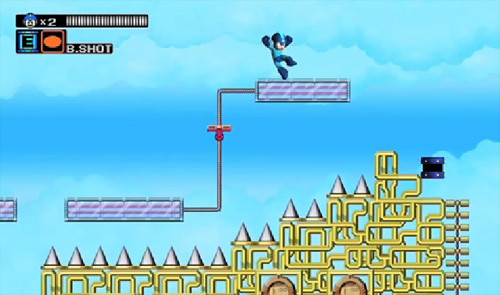
Well, that's not the whole of it. Mega Man Universe's trailer reveals glossy new redesigns of familiar Mega Man 2 levels, with the choice of a pleasant, anime-eyed Rock Man, a somewhat peevish Mega Man, and the now-famous Mega Man from the original game's awful American box art. The footage suggests a two-player mode as well, and the stinger of it all announces Ryu from Street Fighter as a playable character. Arthur from Ghouls 'N Ghosts is likely in there as well, since he was shown in the original comedic trailer for Mega Man Universe.
ARCANA HEART 3, VALKENHAYN AT TOKYO GAME SHOW
Most of North America missed Arcana Heart 2. The original Arcana Heart's PlayStation 2 port squeaked out here thanks to Atlus, but there was no such domestic release for the second game or its expansion, which was called, no kidding, Sugoi!! Arcana Heart 2. Perhaps that's because the PS2 version of the game was a mess. Yet Arcana Heart soldiers on in Japan, and the third game, out in arcades since last December, will debut for the Xbox 360 and PlayStation 3 at the Tokyo Game Show.
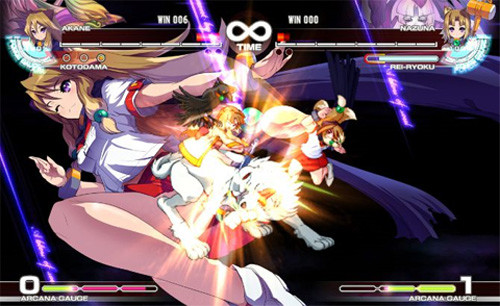
Arcana Heart 3 is largely a refinement of the titles before it, as its special attacks are now governed by a Force Gauge that doesn't sound too different from the Arcana Burst moves in previous games. There's also a lineup of mostly returning characters, with new faces like the long-haired Weiss and the bizarre artist Eko, who's accompanied by one of her living drawings. All of the girls have their own Arcana spirits, which aid them in matches by unleashing special combos or abilities. And, of course, all of the girls are also distinct “moe” types, even the one with the word “felch” in her name.
For those you who prefer fighting games with werewolf butlers instead of dog-eared schoolgirls, Arc System Works will also use their TGS booth to show off Valkenhayn, the newest downloadable character for BlazBlue: Continuum Shift. He's the second of three DLC additions to the game's roster, with the third being a magical girl named Platina the Trinty. Don't worry if you can't attend. Valkenhayn will be available in the game by the end of this month.
REVIEW: METROID: OTHER M
 Developer: Nintendo/Team Ninja
Developer: Nintendo/Team Ninja
Publisher: Nintendo
Platform: Wii
Players: 1
MSRP: $49.99
Metroid always stood out among Nintendo's major franchises. The original was a bleak, claustrophobic maze next to the colorful tones of Mario and Zelda, and the years have seen Metroid become the only one of Nintendo's big guns with a consistently developed storyline. Sure, it's a basic storyline that's conveyed through gameplay, usually serving only to arrange another planet-exploring battle between armored bounty hunter Samus Aran and the giant alien jellyfish known as Metroids. However, it's a part of what's kept the series strong. Metroid co-creator Yoshio Sakamoto certainly thinks as much, and so he and Team Ninja decided to make a Metroid that broke some rules. From the intrusive storyline to the 3-D gameplay, Metroid: Other M plays around with a lot of series conventions, and it's not always for the better.
It's easy to see why Samus Aran would have a lot on her mind. She's spent past Metroid games shutting down intergalactic threats mostly on her own, delivering only a few pieces of exposition here and there. Metroid: Other M changes all that. Shortly after the events of Super Metroid (and before Metroid Fusion), Samus follows a distress signal to the Bottle Ship, a Galactic Federation base apparently devoted to studying various alien lifeforms. There she finds a squad of generic space marines who just so happen to include her former commanding officer, Adam Malkovich. And Samus can't resist telling the player all about this in stiffly acted voiceovers every half-hour or so.
Of course, the ship is filled with secrets, dangers, and various monsters straight out of previous Metroids. Samus explores it mostly by herself, but she's directed by Adam and therefore restricted in the items she can use, as Adam won't authorize weapons that Samus already has until a relevant danger presents itself. This is all a needlessly elaborate excuse for the reliable Metroid formula: Samus is limited in her destinations at first, but every new item opens up new areas of the ship. That said, Other M has a more linear focus, closer to Metroid Fusion than Super Metroid, and it's all used to push forward a story of insidious experiments, betrayals, and a tragic twist that you'll see coming if you played through Fusion.
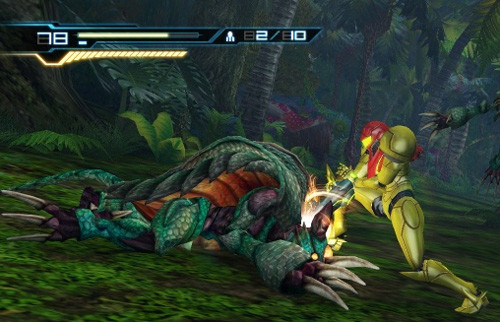
Other M is a strange hybrid, a 3-D action game that often resembles a side-scroller as Samus roams the corridors of the Bottle Ship. Team Ninja's taken pains to present combat as quick and dirty: Samus auto-aims at enemies, leaps atop them, and grabs them to blow them to pieces with a point-blank energy shot. It's fluid, enjoyable, and reminiscent of Team Ninja's tight Ninja Gaiden programming. The boss battles also tend to be clever, and Samus has to rely on carefully timed dodging as well as volleys of missile attacks.
That's only part of the game, though. Samus can also switch to a first-person viewpoint straight out of Metroid Prime, and that's where she fires missiles, uses the grapple beam, and hunts for clues. The last of these eats up a larger chunk of Other M than it should. The game often pauses for Samus to scan the environment, searching for some small hint that'll move the story along. It's a nice integration of Prime's gameplay at first, but it grows particularly tedious when you're forced to seek out a tiny speck of the screen when you're under fire from a boss.
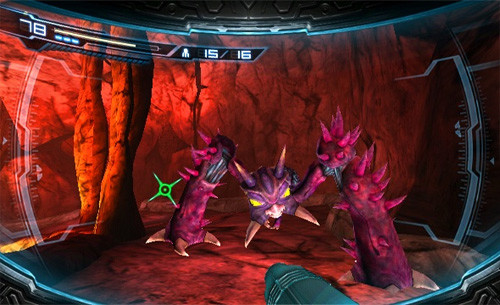
The control is similarly varied in Other M. The standard bug-battling is driven by typical controls, but Samus also uses a health-regenerating feature that requires players to tilt the Wii remote upright and hold A, an action that sometimes works and sometimes just makes Samus roll into a ball. The first-person gameplay handles better, even if it's slow. You're best off using it when an enemy is temporarily stunned or at a distance, unless you enjoy being blindsided by everything.
Yet the real drawback lies with the story. Sakamoto clearly meant well in exploring Samus' history and expanding her character, but those efforts fall completely flat. Most of her narration beats the player over the head with things that were already apparent from the game's normal flow, and the supporting characters aren't terribly interesting, from Adam's stolid, fatherly demeanor to Anthony, a squadmate who calls Samus “Princess.” The awkward, offensively melodramatic writing makes some of the game's underlying ideas seem more stupid and sexist than they actually are. It's one thing to have Samus abandon her solo, galaxy-saving methods for the sake of old military friends and a disappointed faux-parental figure. It's another thing when the military of the future is depicted as male-dominated and condescending. Samus needs flaws if she's to develop beyond a one-dimensional action heroine, but it's just demeaning and inconsistent when she freezes up at a threat that she's already faced in at least two previous Metroid games.
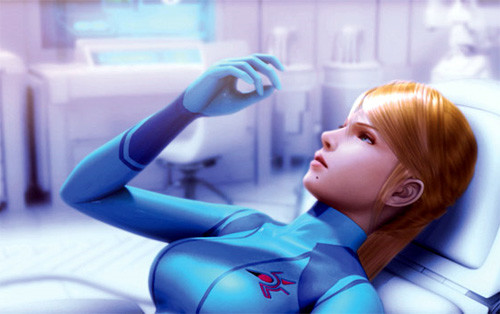
Other M isn't hard to enjoy, though. The gameplay's fast-paced and challenging, even if it reuses mid-bosses a little too often. Despite the groan-inducing dialogue, there's a decent surprise or two in the game, and the Bottle Ship eventually becomes just as open to exploration as the planets of previous Metroids. It all looks good in the midst of battle, though the characters are fairly basic by current standards, as though they're in the CG videos of some last-generation Resident Evil game. The soundtrack gets the job done, but its most interesting tracks come from previous Metroid music.
Aside from its plot, Other M's biggest problem might be its heritage. Its gameplay is a sturdy attempt at a modern Metroid, but it can't really touch Super Metroid or Metroid Fusion in their marvelous, cohesive execution. Those are hard acts to follow, though, and Other M still stands above the current morass of forgettable 3-D action games. For all of its annoyances, it's well worth playing. Even when it can't stop talking.
NEXT WEEK'S RELEASES
GLADIATOR BEGINS  Developer: Acquire
Developer: AcquirePublisher: Aksys Games Platform: PSP Players: 1-2 MSRP: $39.99 Gladiator Begins drew some attention over in Japan for its ads of scantily clad female gladiators, but that may lead some to realize a historical curiosity: women actually were gladiators in Roman times. There were children gladiators as well, but Acquire's gladiator game wisely avoids those. Players have the choice of creating male or female combatants, and they can be customized and seen through all sorts of gory battles. There are one-on-one duels, team battles, and fights against wild animals, all thanks to the historically accurate sadism of the game's Roman rulers. There aren't any Christian-lion matchups, but the game builds an interesting system of weapons and armor, allowing gladiators to knock away enemies' equipment and use it battle. There's also a progressive skill system, a lineup of rich Roman patrons to sponsor you, and a bunch of weapons to seize and upgrade. More will be available as downloadable extras, and I hope some of those extras include blue hair, a monocle, and a laser gun. |
PHANTASY STAR PORTABLE 2  Developer: Alfa System
Developer: Alfa SystemPublisher: Sega Platform: PSP Players: 1-Various MSRP: $39.99 Ye Olde Game Nerd Law demands that I spend part of this writeup talking about the first generation of Phantasy Star games, four fair-to-excellent RPGs that combined sci-fi tropes and typical fantasy like nothing else. And then they gave way to multiplayer-oriented online games that, while mostly good, just aren't the same. Portable 2 may come closer to a cohesive storyline than many other modern Phantasy Stars, though, as the player's self-designed character is the friend of the real protagonist, a strange girl named Emilia. As players shepherd her through the Phantasy Star world of spaceships and techno-magic, she unravels her mysterious past and gains new allies, including the sister of Phantasy Star Universe hero Ethan Waber. The gameplay doesn't change too much when compared with the action-RPG trappings of Phantasty Star Portable, though you're forced to start over at level one if you want to use your original Portable character as the new game's lead. And you might be able to use Emilia in Valkyria Chronicles 2, if the Japanese versions of the two games are any indication. |
PROFESSOR LAYTON AND THE UNWOUND FUTURE  Developer: Level-5
Developer: Level-5Publisher: Nintendo Platform: DS Players: 1 MSRP: $34.99 Professor Layton's not just for games anymore, you know. Guy's got a movie, action figures, and probably a bunch of monogrammed Professor Layton beach towels. But he's still the star of a constant stream of puzzle-based adventure games, which usually trickle out to the U.S. years after their Japanese releases. Though it originally came out in Japan back in 2008, The Unwound Future has an interesting time-travel angle, putting Layton into a London several decades distant, where he and his assistant Luke Triton solve puzzles and face off with the future version of Luke himself. While it's not the most recent Layton game, The Unwound Future is latest in terms of the series' chronology, so if there are any drastic, storyline-ending events to occur, they'll be occurring here. Not that Level-5 would put the Layton cash cow in danger. |
EXTRA LIVES: METROID MANGA
 There's a long-running theory about the original Metroid not being all that successful in Japan, at least not to the extent of Super Mario Bros. and The Legend of Zelda. If true, that hasn't stopped anyone from making a few Metroid comics over the years.
There's a long-running theory about the original Metroid not being all that successful in Japan, at least not to the extent of Super Mario Bros. and The Legend of Zelda. If true, that hasn't stopped anyone from making a few Metroid comics over the years.
The first Metroid manga was part comic and part strategy guide. Released shortly after the game's 1986 debut on the Famicom Disk System, the manga features Samus running through the game's setting while sharing all sorts of tips. Her look varies from a google-eyed, super-deformed Samus to a full-size one, but the comic ends without revealing her as a woman. Instead, players are promised the chance to see her true identity if they finish the game.
Samus Aran's first appearance in an ongoing comic series wasn't in Japan, but in an American-born product of Nintendo's marketing. Captain N: The Game Master is best known as a generally horrible cartoon that every Nintendo-crazed kid loved back in 1989 or so. It follows the teenage Kevin Keene's adventures in frequently bizarre dimension full of game characters, including grotesque versions of Simon Belmont and Mega Man. Samus Aran isn't among them, even though the show's main villain was Metroid's Mother Brain (voiced by Levi Stubbs in an odd Little Shop of Horrors reference). Yet Samus is in the comic version of Captain N: The Game Master.
 Introduced with the same surprise that awaited players at the end of the original Metroid, Samus becomes a member of Captian N's entourage and the third side of a love triangle involving our hero and the bland Princess Lana. When not throwing herself at the teenage Captain N (or carrying him around), Samus is a constantly aggressive warrior, almost beyond what a simple comic about goofy video-game characters requires.
Introduced with the same surprise that awaited players at the end of the original Metroid, Samus becomes a member of Captian N's entourage and the third side of a love triangle involving our hero and the bland Princess Lana. When not throwing herself at the teenage Captain N (or carrying him around), Samus is a constantly aggressive warrior, almost beyond what a simple comic about goofy video-game characters requires.
The comic's a pure slice of Nintendo-brand cheese, though the writers showed a bit more creativity than those from the TV series. In fact, a lot of their ideas are wrapped around Samus. She brings a weird pulp-heroine presence to the whole comic. One can only imagine how the Captain N cartoon would've fared if it had dedicated episodes to Samus traveling to a bleak future or singlehandedly beating up an entire prison full of Metroid monsters.
The Captain N comics joined similar books based on Super Mario Bros. and The Legend of Zelda, but Samus Aran's spot in Captain N was as much of an American comic as Metroid had in the NES days. It was forced to wait down among the lower-tier Nintendo properties like Kid Icarus, StarTropics, and Clu Clu Land for another chance at literary adaptation.
 Nintendo's next attempt at a Metroid comic was inspired by Super Metroid, the well-received Super NES entry in the series. Prior to the game's American release, Nintendo Power ran a Super Metroid series by Benimaru Itoh. The magazine previously carried original Mario comics as well as a The Legend of Zelda series by manga icon Shotaro Ishinomori, but Nintendo turned to Itoh in adapting StarFox and Super Metroid. His version of Samus Aran was described by Nintendo Power editors as “between Princess Leia and Ripley of the Alien series,” and she's pretty much the hard-edged bounty hunter envisioned by the games. The purple hair was never really explained.
Nintendo's next attempt at a Metroid comic was inspired by Super Metroid, the well-received Super NES entry in the series. Prior to the game's American release, Nintendo Power ran a Super Metroid series by Benimaru Itoh. The magazine previously carried original Mario comics as well as a The Legend of Zelda series by manga icon Shotaro Ishinomori, but Nintendo turned to Itoh in adapting StarFox and Super Metroid. His version of Samus Aran was described by Nintendo Power editors as “between Princess Leia and Ripley of the Alien series,” and she's pretty much the hard-edged bounty hunter envisioned by the games. The purple hair was never really explained.
Foreshadowing Metroid: Other M's attempts at broadening a story, the comic follows the events of the Super NES game and adds details and new characters along the way. Most of them are unnecessary. There's a bearded, blue-armored bounty hunter named Armstrong Houston to get in the way, plus a bossy Galactic Federation chancellor named Keaton and a fat, inept police chief named Hardy. This cutting-edge comedy failed to bring much to the Super Metroid storyline, and the comic even fumbles some of the game's best moments. It also wraps up rather quickly. Most of the other Nintendo Power comics ran for a year, but the magazine stopped its Super Metroid serial after six months.
 The Metroid franchise laid dormant for the rest of the 1990s, and it wasn't until 2002's Metroid Fusion that another decent-sized comic emerged. A new manga was commissioned and featured on Nintendo's site, all to promote Fusion. It's easily the most interesting Metroid comic out there. While it was written by Koji Tazawa and illustrated by Kenji Ishikawa, it was overseen by Metroid co-creator Yoshio Sakamoto, and it's very much his attempt at clearing up the franchise's backstory.
The Metroid franchise laid dormant for the rest of the 1990s, and it wasn't until 2002's Metroid Fusion that another decent-sized comic emerged. A new manga was commissioned and featured on Nintendo's site, all to promote Fusion. It's easily the most interesting Metroid comic out there. While it was written by Koji Tazawa and illustrated by Kenji Ishikawa, it was overseen by Metroid co-creator Yoshio Sakamoto, and it's very much his attempt at clearing up the franchise's backstory.
Much of the manga is consistent with previous Metroid adaptations: Samus Aran was the only survivor of a space-pirate attack on a human colony, and she was subsequently raised by a declining alien race called the Chozo. Equipped with a powerful suit of Chozo-made armor, Samus sets out to destroy the pirates and end their attempts to breed Metroids for fun and conquest. Other characters show up along the way, including the dragonlike Ridley, some younger admirers for Samus, and, curiously, Chairman Keaton and Chief Hardy from the Nintendo Power comic. Adam Malkovich also appears, and the comic ties directly into Fusion and, by extension, Metroid: Other M.
The two-volume Metroid manga suffers from a common flaw of game-based comics: it's not particularly interesting to casual readers. For fans, though, it's an intriguing look at Sakamoto's broader ideas for Metroid, and it lays the groundwork for his current plans regarding the series. Unfortunately, it was never officially translated. Tokyopop seemingly licensed the manga and listed it on release schedules around 2004, but it never showed up. Instead, they gave us Princess Ai poetry books.
Other Metroid comics emerged around the same time, including Nintendo Power's brief Metroid Prime story and a silly, Japan-only manga entitled Samus and Joey, in which a wide-eyed kid tags along on Samus' adventures (suffice to say, it's not canon). Of course, there are Metroid doujinshi aplenty, and most of them wouldn't pass Nintendo's censors. Yet it seems inevitable that we'll see more officially endorsed Metroid manga in the future. After all, Other M proves just how much Nintendo and Sakamoto want Metroid's storyline to matter.
The Captain N comics are long out of print, but they're not hard to find used. Benimaru Itoh's Super Metroid comic was published only in Nintendo Power, unlike the separately compiled Mario and Zelda comics. Tazawa and Ishikawa's Metroid manga was released only in Japan, as was Samus and Joey. The Metroid Database has more information on these and other minor Metroid comics.
discuss this in the forum (29 posts) |
this article has been modified since it was originally posted; see change history